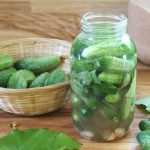Old Fashioned Salt Pickles
Learn how to create traditionally fermented cucumbers in a mason jar for a salty, gut boosting snack!
Servings: 1 half gallon jar
Equipment
- cutting board
- small kitchen knife
- 1 half gallon (2 litre) glass jar with lid
- 1 glass weight
- a measuring spoon (tablespoon)
Ingredients
- 4 lbs (1814 gm) small pickling cucumbers
- 1 bulb garlic (6-8 cloves)
- 2-3 heads of fresh dill
- 5 grape leaves
- 2 tablespoons sea salt or Himalayan salt
- 5-6 cups filtered water to cover cucumbers
Instructions
- Harvest cucumbers, dill and grape leaves in the morning, while it's still cool outside.
- Bring your harvest inside, rinsing cucumbers, dill and grape leaves at the kitchen sink to remove dust and any tiny insects.
- If your cucumbers still have wilted blossoms attached to the tip, be sure to remove them so the enzymes don't soften your pickles (keep it crunchy, right?!).
- Measure 2 tablespoons of salt into your jar.
- Peel garlic cloves and also add to your jar.
- Add about 3 inches of water to the jar and swish water around to start dissolving salt.
- Stuff the heads of fresh dill into your jar.
- Fill the jar with fresh cucumbers, until you reach the halfway point.
- Put down a layer of grape leaves (2-3 leaflets should be enough).
- Continue adding cucumbers on top of grape leaves, until you reach the neck of your jar.
- Stuff the remaining 2 grape leaves on top, covering the cucumbers underneath.
- To finish, top the jar off with water, until it reaches the jar's neck as well.
- If using, plop a glass fermenting weight into place.
- Cover your jar with a lid.
- Tip the jar back and forth several times to finish dissolving the salt and evenly spread the brine throughout.
- Leave it to ferment at the back of your kitchen counter in temperatures no higher than 75F (24C).
- When the brine start to turn cloudy, test your pickles. If you're happy with the flavor, you can use them immediately or pop them into the refrigerator. But if you want more sourness, let them ferment another 3-4 days before testing again.
- Traditionally fermented cucumbers (like these ones) can be refrigerated up to 6 months or more.
